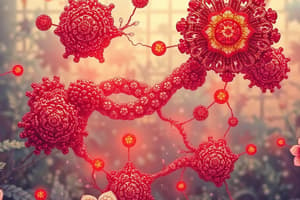Podcast
Questions and Answers
What role do enzymes play in the orientation of substrate molecules?
What role do enzymes play in the orientation of substrate molecules?
- They inhibit the formation of products.
- They separate the atoms of substrates.
- They destroy bond stability in substrates.
- They bring together the atoms that will bond. (correct)
Which of the following statements is true regarding enzyme concentration compared to substrate concentration?
Which of the following statements is true regarding enzyme concentration compared to substrate concentration?
- Enzyme concentration is usually much lower than substrate concentration. (correct)
- Enzyme concentration does not affect substrate concentration.
- Enzyme and substrate concentrations are always equal.
- Enzyme concentration is typically much higher than substrate concentration.
Which factor does NOT affect enzyme activity?
Which factor does NOT affect enzyme activity?
- pH
- Cofactors
- Substrate temperature (correct)
- Temperature
What is the main effect of enzymes on the activation energy of a reaction?
What is the main effect of enzymes on the activation energy of a reaction?
At what point does an enzyme reach maximum reaction rate?
At what point does an enzyme reach maximum reaction rate?
What is 'turnover' in reference to enzyme activity?
What is 'turnover' in reference to enzyme activity?
Which of the following best describes cofactors in enzyme activity?
Which of the following best describes cofactors in enzyme activity?
Which of the following factors can act as inhibitors in enzyme activity?
Which of the following factors can act as inhibitors in enzyme activity?
What is the primary role of enzymes in biochemical reactions?
What is the primary role of enzymes in biochemical reactions?
What do we call the reactants that are acted upon by enzymes?
What do we call the reactants that are acted upon by enzymes?
Which statement about activation energy is true?
Which statement about activation energy is true?
What term describes the specific region where a substrate binds to an enzyme?
What term describes the specific region where a substrate binds to an enzyme?
How do enzymes achieve specificity for their substrates?
How do enzymes achieve specificity for their substrates?
What happens to enzymes after they catalyze a reaction?
What happens to enzymes after they catalyze a reaction?
What is the term for the unstable form of reactants that occurs during a reaction?
What is the term for the unstable form of reactants that occurs during a reaction?
Which statement is NOT true about enzymes?
Which statement is NOT true about enzymes?
What is the role of a competitive inhibitor in enzyme activity?
What is the role of a competitive inhibitor in enzyme activity?
Which factor does NOT affect enzyme denaturation?
Which factor does NOT affect enzyme denaturation?
What is the effect of irreversible inhibition on an enzyme?
What is the effect of irreversible inhibition on an enzyme?
Which of the following correctly describes an enzyme activator?
Which of the following correctly describes an enzyme activator?
What is the primary consequence of high temperature on enzyme structure?
What is the primary consequence of high temperature on enzyme structure?
Which aspect of enzymes is affected by pH levels?
Which aspect of enzymes is affected by pH levels?
In metabolic pathways, what is the commitment step?
In metabolic pathways, what is the commitment step?
What typically happens to an enzyme's tertiary structure at high temperatures?
What typically happens to an enzyme's tertiary structure at high temperatures?
Flashcards are hidden until you start studying
Study Notes
Active Site Formation
- Enzymes play an important role in catalysis by bringing substrates together in a specific orientation and promoting bond formation.
- Enzymes can stretch the bonds in substrate molecules, making them unstable.
- Enzymes can temporarily add chemical groups to substrates.
- Enzymes lower the activation energy of a reaction by bringing substrates together in a way that facilitates the reaction.
Catalyzed Reactions
- The rate of a catalyzed reaction depends on substrate concentration.
- At saturation, all enzymes are bound to substrates, leading to a maximum rate.
- The rate can be used to calculate the enzyme efficiency: the number of substrate molecules converted to product per unit time (turnover).
Properties of Enzymes
- Most enzymes are proteins; however, ribozymes are RNA molecules that act as enzymes.
- Most enzyme names end in "-ase."
- Enzymes lower the activation energy of a reaction but do not change the equilibrium constant (ΔG).
- Enzymes are very specific for the reactions they catalyze and have a specific active site that binds to the substrate.
- Enzymes can be regulated by different factors, including temperature, pH, cofactors, and inhibitors.
Enzyme-Catalyzed Reactions
- Enzymes are not consumed during a reaction and can act repeatedly.
- Reactants acted upon by enzymes are called substrates.
- The enzyme-substrate complex is held together by various interactions: hydrogen bonds, electrostatic interactions, hydrophobic interactions, or even covalent bonds.
Activation Energy
- Activation energy is the initial energy required for a reaction to take place, even if the overall reaction is energetically favorable (ΔG < 0).
- Enzymes lower the activation energy barrier by bringing reactants together, increasing reaction rates.
- Enzymes do not change the ΔG of a reaction; they only accelerate the rate at which equilibrium is reached.
Enzyme Shape and Active Site
- The active site is the catalytic center of the enzyme.
- The shape of the active site allows specific substrates to bind to the enzyme, often described as a "lock and key" model.
- Often, enzymes undergo a conformational change upon substrate binding, called induced fit.
- The active site stabilizes the transition state, further lowering the activation energy.
Enzyme Inhibitors
- Enzyme inhibitors are substances that block the action of an enzyme.
- Two important types of inhibitors:
- Competitive inhibitors: resemble the substrate and bind to the active site of the enzyme.
- Non-competitive inhibitors: bind to a different site on the enzyme, affecting its catalytic activity.
- Inhibitors can be reversible or irreversible.
- Irreversible inhibition occurs when the inhibitor covalently binds to the active site, permanently deactivating the enzyme.
Regulation of Enzyme Activity - Temperature
- Each enzyme has an optimal temperature for activity.
- At high temperatures, non-covalent bonds in the enzyme can break, leading to denaturation.
- Denaturation is the loss of the enzyme's three-dimensional structure, resulting in the loss of function.
Regulation of Enzyme Activity - pH
- Each enzyme has an optimal pH for maximum activity.
- pH influences the ionization state of functional groups, affecting the enzyme's structure and catalytic activity.
Regulation of Enzyme Activity - Activators
- Enzyme activators are molecules that accelerate the activity of an enzyme.
Metabolic Pathways
- Metabolic reactions are organized into pathways, which are orderly series of enzymatic reactions.
- The first reaction in a pathway is often the commitment step, and subsequent reactions follow in sequence.
- These pathways are controlled by enzymes, ensuring the efficient flow of energy and molecules within a cell.
Studying That Suits You
Use AI to generate personalized quizzes and flashcards to suit your learning preferences.





